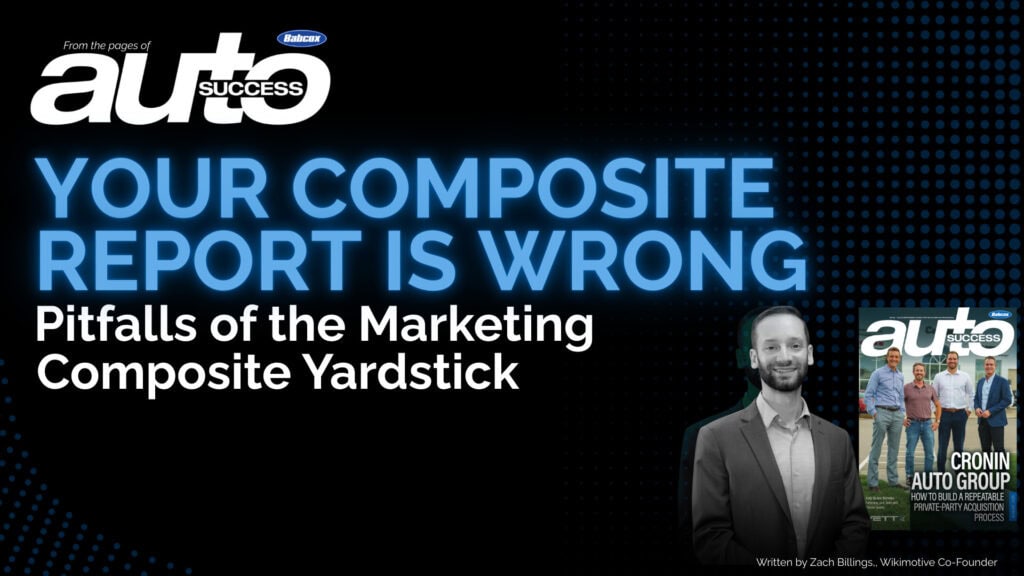
In today’s installment of “Stuff I Mythbusted This Week,” we have a story from a 20 group. Most myths seem to propagate through 20 groups, so this isn’t a shock, but just about everyone reading this will face this exact problem at some point.
There’s no doubt that your 20 group is an excellent place to gather new ideas and expand your thinking beyond your four walls. They can also be an echo chamber where ideas are amplified, both good and bad, and your well-meaning moderator may not always have the subject matter expertise to call foul.
Let’s explore one of the most common ways that well-intentioned information turns into flawed decision-making.
Marketing Composites – The Good and Bad
All too often, I have dealers come to me for help, deeply concerned about the results of their latest 20-group digital composite. I love data, and 30,000 ft data can tell you a lot about market realities, and the tidal forces working with or against your success. Composite reports have become popular in various 20 groups and the idea is to show how your store’s digital stats compare to the average of your 20 group.
Composite stats typically include things like traffic, time on site, conversions, calls, chats and forms. The idea is that you compare your stats to the rest of your 20 group, which gives you a frame of reference for how you’re performing. This is a great idea at face value, but there are problems with it in practice…
As one of my dealers learned the hard way in July, Google Analytics data is NOT the same thing from one store to the next. He was deeply concerned about how much ground he seemed to have lost against his 20 group composite. The group’s average conversion (lead) count had gone up by more than his, and his traffic — which had been miles ahead of his group — had dropped.
My dealer was ready to make significant marketing changes and was calling into question years of partnership decisions. After all, these reports said he’d tumbled from 20-group hero to 20-group zero in a short time!
How Composites Lead to Bad Decisions
The devil was in the details in this example. My dealer’s store actually had more leads, and his sales were significantly outpacing his state and his region — he just reached #1 volume dealer in his region for the first time. The real-world figures showed things were firing on all cylinders, so why did the composite paint a gloomy picture? Let’s break down what happened and how each measure can be wrong…
Traffic
My dealer’s traffic was over 45,000 sessions per month and tumbled down to 30,000, roughly the same as his 20 group average. Turns out the ⅓ of his traffic that vanished was low-quality traffic. Some of his paid ads were driving bot traffic, and his website vendor had made a number of blog articles that were bringing in extreme-high-funnel sessions for people wanting to know things like towing capacity and EV range — these people don’t have immediate shopping intent!
The result is that it looked like he lost a lot of traffic, but he really just trimmed the fat. Alarming on paper, but his conversions were actually up!
Conversions
My dealer’s conversion count had been steadily increasing, but his 20 group’s average had suddenly gone from behind him to ahead of him. The numbers would suggest he was walking while the rest of the market was running past him, so he was rightly concerned. The problem here is that composite reports wouldn’t be scalable if you had to break down every data point and check its accuracy, and the source for conversion info is just Google Analytics. If my dealer is only tracking forms and calls as conversions, but some of his 20 group starts tracking VDPs and button clicks as conversions too, what do you think happens? They start posting bigger numbers, but their CRM would not reflect that increase.
My dealer’s sales and market share were stronger than ever and his 20 group members were not seeing the same. Their stats may have shot up, but only because they were measuring soft navigation and calling it conversions. This inflated the 20 group numbers while his remained accurate.
Check Your Yardstick
At Wikimotive we do digital marketing for about 200 dealers. We are very hands on with our dealers and their data, giving us uniquely deep context on this issue. Data, metrics, analytics… they are critical to making informed marketing decisions but they can be easily inflated or deflated.
Make sure you understand what can impact your data points and be sure you understand what you’re comparing yourself to before you put stock in a composite. There may be more to it than meets the eye.
I offer a free marketing analysis for dealers who are trying to get their bearings. SEO, SEM, third party, analysis and more are included and I’ll meet with you personally to review findings. Just inquire on our site or each out to me and I’ll set you up with a free analysis.